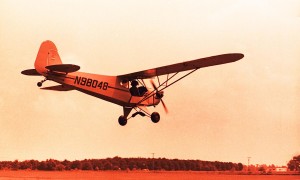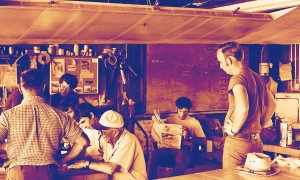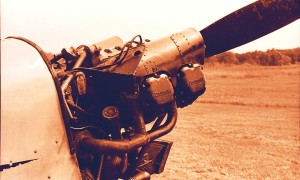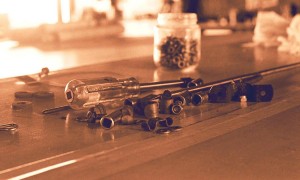First it was the Dzus key, then the old high school yearbooks. Then we hit the mother lode. We found some very important old photos for which I had been searching for a long time. I shot these photos as a student in journalism school. They were B&W images of Charlie’s place, the airport where I became a pilot.
I learned to fly in the summer of 1971. Charlie’s Airport was a short 2300 foot grass strip and he operated three Piper J-3 Cubs and a 1959 Cessna 150. He taught people how to fly in the Cubs and then prepared each student for their private pilot checkride in the 150. It was a wonderful way to learn how to fly.
Going through these photographs brought back so many memories. I had to laugh at the hair styles and fashions of the 1970s. And as much as hair styles and fashions have changed, the airplanes, the laws of aerodynamics and physics, and learning the basics of flying have not changed at all.
When Charlie taught us how to fly, we learned the rudiments of flying first without worrying about talking on radios or using electronic navigation. We focused entirely on the art of flying. We would worry about radios and VOR navigation later; the focus was first on learning how to be safe and skillful pilots.
There was no schedule book Charlie’s. There was a bench facing the landing area of runway nine and when a student arrived, he would take his place on the bench. Then he would wait his turn.
While waiting, we on the bench would critique and learn from watching other student pilots land. Charlie would fly each student only 30 minutes. At the end of one student’s lesson, Charlie would taxi the airplane over near the bench and the student would climb out. The next student in line on the bench would then climb into the backseat of the Cub. He and Charlie would taxi out to take off and the rest of us shifted down one on the bench to continue waiting. Then we would carry on learning and critiquing until it was our turn.
While waiting, we on the bench would critique and learn from watching other student pilots land. Charlie would fly each student only 30 minutes. At the end of one student’s lesson, Charlie would taxi the airplane over near the bench and the student would climb out. The next student in line on the bench would then climb into the backseat of the Cub. He and Charlie would taxi out to take off and the rest of us shifted down one on the bench to continue waiting. Then we would carry on learning and critiquing until it was our turn.
Occasionally, if the winds were calm, you could actually hear and understand Charlie teaching the student while on downwind at 700 feet. We could hear him because this was back in the “old” days when we did not protect our hearing well enough. We climbed into the airplane without any hearing protection and listened to the roar of the mighty 65 hp Continental engine and tried to understand what Charlie was saying. While it was bad for our hearing in the airplane, listening to Charlie from the ground also helped us with our learning.
In addition to learning how to fly, we learned other things at Charlie’s. If you were hanging around and it was too hot to sit on the bench or the wind was too tricky to fly, there was always a Cub in some state of rebuild to help with finishing. While rebuilding a Cub, this allowed us to learn about how airplanes worked. It was a wonderful lesson covering many subjects; aeronautics, mechanical engineering, fabric work, engines, using tools, airframes, and getting along with others. This was a wonderful education which turned out far more fun than I ever imagined.
I wish I could go back there and sand one of the wings one more time. And maybe fly 69 Hotel once more again.
-30-
© 2010 J. Clark





I loved reading about your flight training at Charlie’s. There is so much a person can learn from watching other pilots and talking to them. I like the fact that you got to work on the planes as well. When I was in training my CFI took me into the maintenance area to see a engine that was being overhauled on a 152 that I usually flew. The motor was completely apart.
He thought that he would stump me by picking up the parts and asking me the names. What he didn’t know at the time is that I am the wife of a mechanic and I have spent a lot of time around motors especially when my husband and sons starting racing.
I’m looking forward to reading more of your blog when I have some time. Love the old photos. Photography is another interest of mine.
Thank you, Jeanne. It was a grand time learning to fly at Charlie’s and there is nothing more fun than a J-3. If you have the chance to go try one, fly it. You’ll like it – I guarantee! (Fly it with the door open…)
I’m glad you were able to teach your CFI a lesson about teaching – never assume anything about a student’s backgroud. 😉
Charlie Miller signed me off for my check ride on 3/12/76. On 3/20/76 he sent me on a solo 3-leg cross country in N98048 ….. he scheduled my check ride that same day in the Cessna 150 (6487 Tango)….. What a day in my life for a 17 year old kid !! I have some photos you may be interest in …… airplane engine oil in Old Heaven Hill whisky bottles ….. flying in formation with Col. C.W. Miller the lead bird over Sebring Race Track…. and others.
Clayton, yes of course, I would be interested in your photos. We’ll connect somehow and figure it out. We need to talk and reminisce.
Very interesting. I have a high school classmate that also learned to fly at Charlie Miller’s Airport. His name is Norman Schmidt. Although Norman never went any further than learning to fly, I believe he would have enjoyed aviation much more if he had stayed with it a little longer especially with the more modern aircraft and the new age of the ultralights. I took my flying lessons at Lakeland Regional Airport, but I too did not continue to fly after learning to solo. My problem though was finances at the time. However, I enjoy flying with my brother (Lawrence Jenkins of Hernando Mississippi) who has a home built RV-6 and has just finished restoring a 1949 Piper Clipper. I can hardly wait to ride in the Clipper! Small aircraft aviation is a real stress reliever….that is if you’re not having to do anything to the aircraft other than flying it.